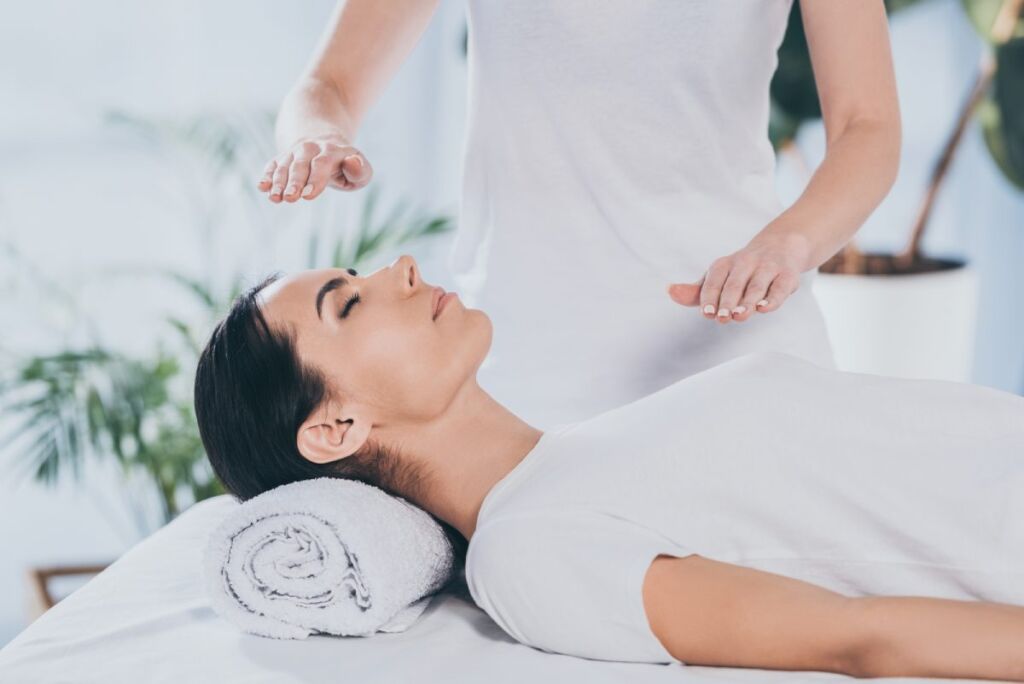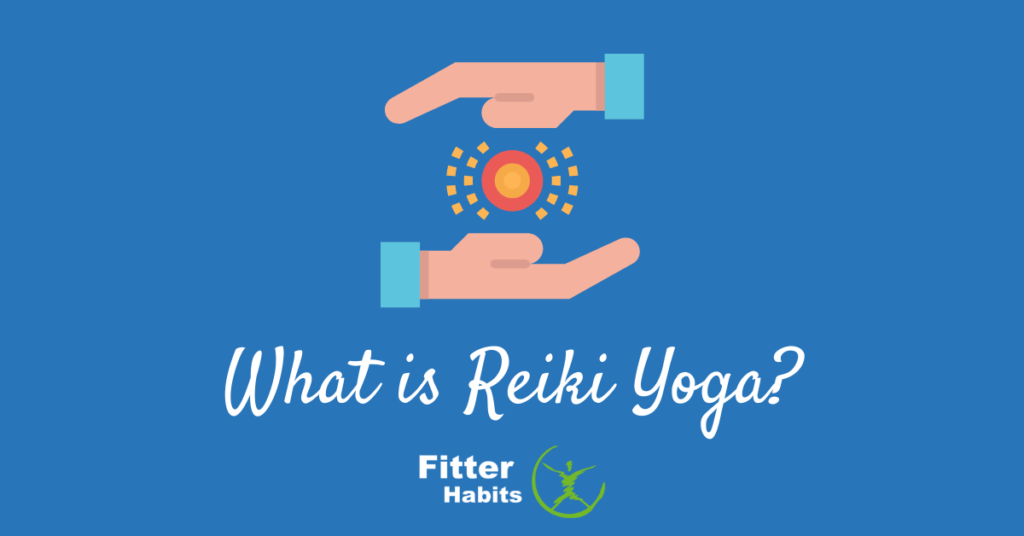Reiki yoga combines Reiki treatment with restorative yoga to help you achieve energetic flow.
In the moment after birth, when a newborn is placed in its mother’s arms and stops crying, it learns the soothing power of the combination of gentle physical touch and loving energy.
This understanding manifests every time a child with a painfully scraped knee asks an adult to “kiss it and make it better.” As we age soothing touch is no less valuable; for example, in moments of deep grief, kind words are often less comforting than an empathetic hug.
These examples help explain why Reiki–a healing technique based on gentle touch and energy work–is becoming increasingly popular to treat a wide variety of physical and emotional conditions, particularly among people who get inadequate relief from modern medicine.
As Reiki has spread, over the last century, it has taken on many forms, one of which is Reiki yoga. Reiki yoga is a gentle relaxation technique that hybridizes two complementary health and wellness traditions into a new alternative healing practice. If you’re a yogi and interested in adding a new element to your practice, you may want to look more deeply into Reiki.
Contents
History of Reiki

While yoga has been practiced for more than five thousand years and originates in India, Reiki originated in 1920s Japan, founded by Dr. Mikao Usui. During his training as a Buddhist monk, Dr. Usui participated in a 21-day training retreat involving meditation, fasting, and prayer. On the last day, he had an epiphany and went on to create Usui Reiki. He established a clinic in Kyoto and taught other Reiki practitioners who spread the healing modality around the world.
You might also be interested in our reiki vs. yoga guide.
Basics of Reiki
Reiki is a Japanese form of natural healing, which translates roughly to “spiritually guided life force energy.” The “Ki” in Reiki, meaning universal energy, is similar to concepts like prana in yoga, or chi in Chinese medicine.
The concept underlying Reiki is that we are all guided through life by this universal flow of energy, which determines our mental, physical, and emotional well-being. Free flowing energy is healthy, while blockages in energy are harmful. Blockages are caused by negativity, anxiety, and fatigue, for example.
This universal life force is sometimes referred to as a “biofield.” While there is no scientific technology that can confirm its existence or describe its nature, one theory is that it is related to vibration. Restoring balance in the biofield is the aim of a variety of practices, such as acupuncture, qigong, shiatsu, and pranayama, not only Reiki.
Reiki practitioners believe that the body is capable of healing itself. The practitioner helps the recipient release blocked energy. This typically involves gentle pressure from the practitioner laying their hands on parts of the recipient’s body.
In other cases, the practitioner may hold their hands over or near the person instead, and the treatment may even be conducted remotely. Practitioners may use other gentle, non-invasive measures to redirect the recipient’s energy.
Reiki is not regulated, although there are training programs. Because of the lack of regulation, different practitioners of Reiki may use different techniques. However, there are generally three levels of Reiki training or “attunements.” The first degree is a basic course available to anyone, the second degree qualifies you as a practitioner, and the third degree makes you a Reiki master, entitled to teach others.
A practitioner of Reiki yoga typically combines the two practices by using their Reiki techniques for creating energetic flow while the recipient is in particular yoga positions. Reiki’s focus on the balance and flow of universal energy harmonizes well with the slow-paced and restorative aspects of Yin yoga.
Process of Reiki

Some practitioners believe Reiki can be effective when performed remotely, even when the practitioner and recipient are miles apart. However, it is much more common to do Reiki in person, particularly when it is being combined with yoga.
A Reiki practitioner typically prepares for a session by engaging in focused breathing, deliberately activating their sense of being in touch with the flow of universal energy. Some practitioners visualize this energy as white light shooting out of their hands, hearts, and the crowns of their heads. The practitioner meditates on their role as a healer.
When the session begins, the recipient will be asked to lie down and relax (fully clothed). The practitioner may lead them into a meditative state. The recipient may even fall asleep.
During the session, the practitioner will lay hands in particular positions on or above the recipient’s body. These locations are often related to the chakras. The practitioner will also speak to the recipient, encouraging them to imagine their body healing itself, or using a mantra, for example.
Other techniques involved in Reiki sessions can include centering, clearing, beaming, extracting negative energy, infusing positive energy, aura smoothing, and aura raking. Some practitioners use crystals, powders, smoke, or “chakra healing wands” in their practice, although this is not typical.
A session may be as short as a few minutes or last more than an hour. Practitioners typically end a session with a closing ritual, in which they acknowledge the completion of the session by “sealing off” the energy. The idea is that the session has opened an energetic pathway between the two people, and it needs to be closed again.
Integrating Reiki into an asana yoga practice can be as simple as using Reiki hands on the recipient while they are in yoga poses that give good access to the appropriate body part.
Another way to combine them is to use Reiki during or after savasana. For more specific suggestions on how to integrate yoga and Reiki, check out this list.
Effects of Reiki
Research into Reiki is conflicting, and much of it is based on self-reported outcomes rather than objective measurements in double-blind studies. That means it is unclear to what extent the effects of Reiki are psychosomatic–caused by the recipient’s belief in the benefits of Reiki, in other words a placebo effect–rather than being caused by the Reiki itself.
There is also a glaring absence of a biomedical explanation for how Reiki might work. However, some studies have shown Reiki to be more effective than a placebo, and many recipients (including some sceptics) report a wide range of sensations and positive effects from a Reiki treatment.
Commonly reported physical sensations and effects during a session include warmth, a tingling feeling, deep relaxation, a sense of pressure on the chest, uncontrollable shaking in parts of the body, pain or nausea abatement, and sleepiness, for example. Reported psychological effects include stress reduction, mental relaxation, serenity, grounding, and emotional flow or realignment.
Some Reiki adherents claim that Reiki can also be used to treat serious medical conditions ranging from cancer to autism to Crohn’s disease. There is no convincing research to back up these claims, however. In fact, some reviews of the scientific literature (in 2008 and 2015, for example) have not found any reliable evidence that Reiki has any substantial physical or mental health benefits.
However, because of its noninvasive nature, Reiki is not known to have any negative effects. Similarly, restorative yoga and Yin yoga are generally considered safe, low-impact practices. That means the combination, Reiki yoga, is likely to be a safe and healthy activity, even for people with serious illnesses or disabilities.
The only substantial risk of harmful effects from Reiki yoga (other than the effect on your bank balance) would arise if your belief in Reiki’s effectiveness deterred you from getting conventional treatment for a medical condition. That partially explains why Reiki is now an option offered in many major hospitals and hospice facilities, despite skepticism by most medical professionals about its healing potential.
What is Reiki Yoga: The Bottom Line
For many sceptical yogis, Reiki may seem a little too “woo woo” to be worth the price of a session, which can be quite expensive. However, for other yogis the opportunity to take the healing qualities of yoga to the next level, using a safe and non-invasive alternative healing practice, will be welcome.
If you do want to expand your energy work, you can look for a Reiki yoga class, make a private appointment with a practitioner, or even learn to use Reiki techniques on yourself.
If you liked this post, you might also be interested in learning about Fusion yoga.



